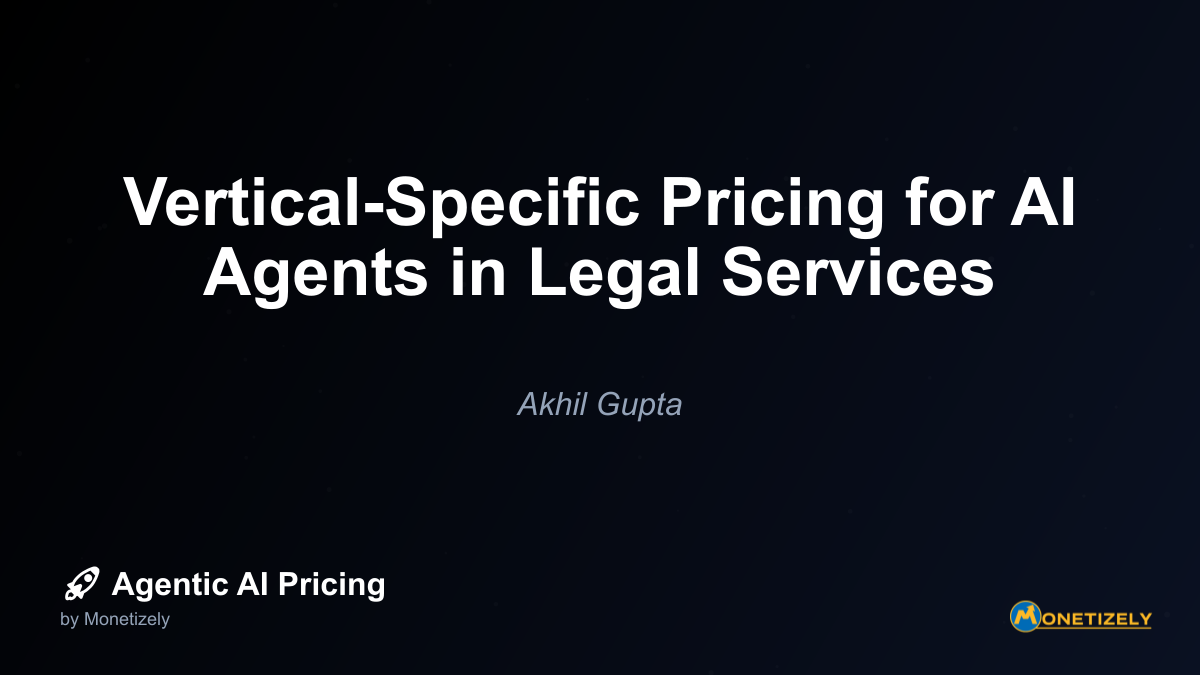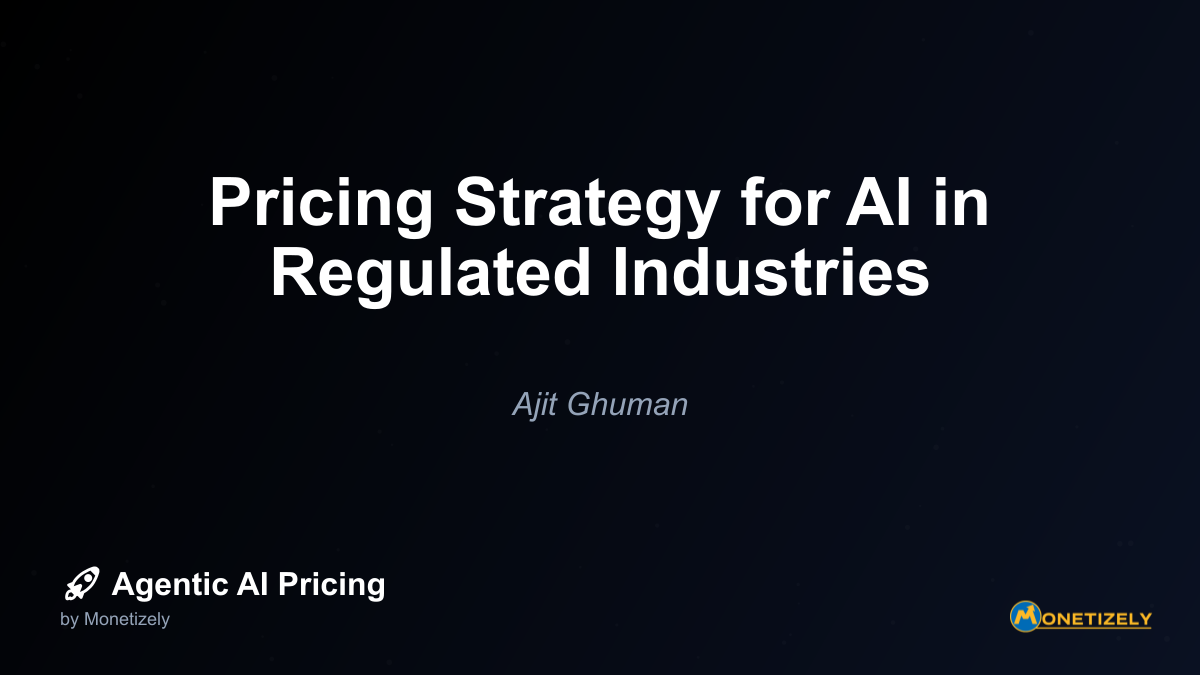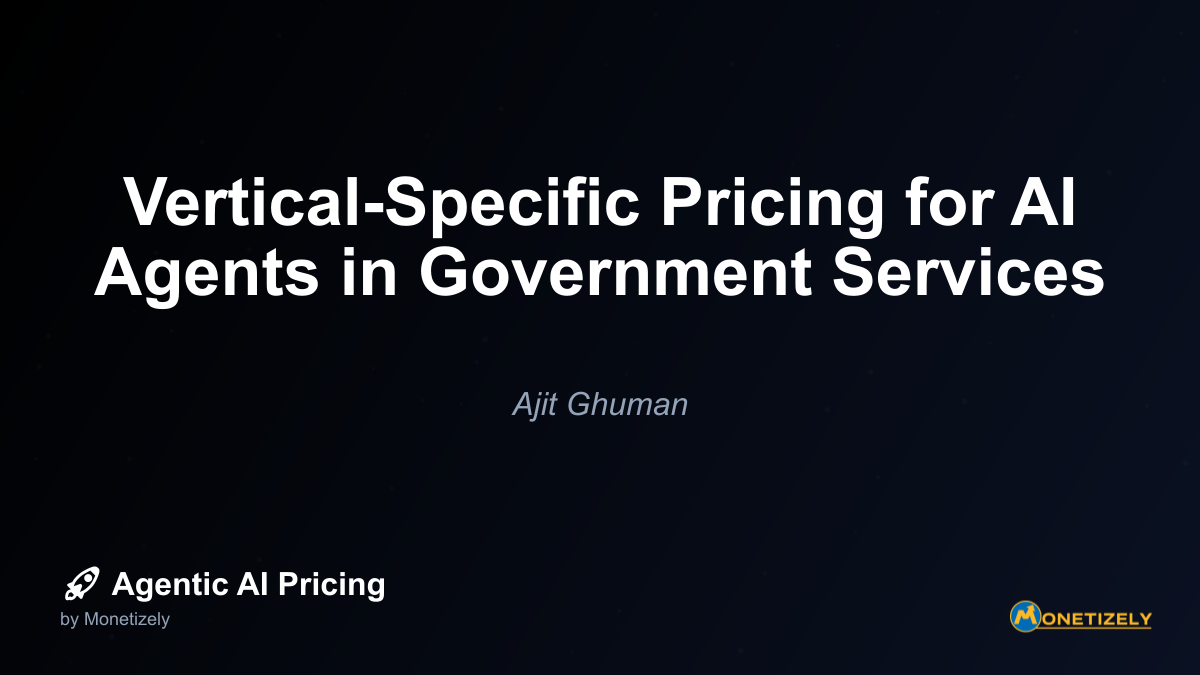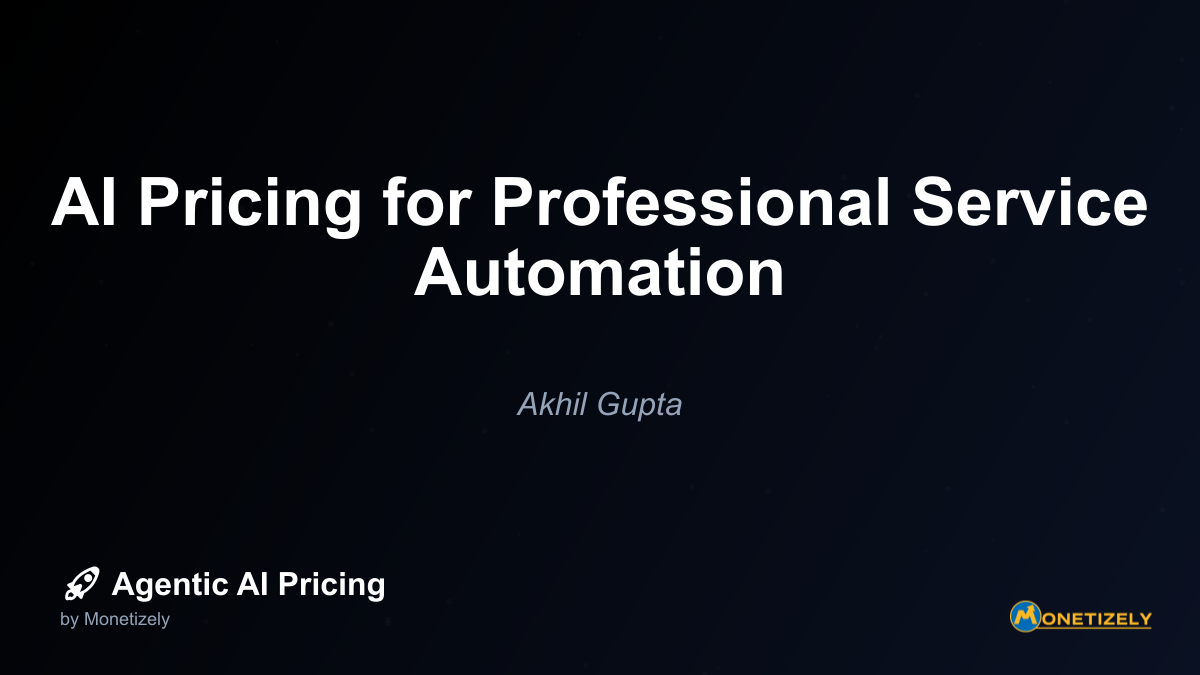· Akhil Gupta · Industry-Specific · 14 min read
Vertical-Specific Pricing for AI Agents in Financial Services
AI and SaaS Pricing Masterclass
Learn the art of strategic pricing directly from industry experts. Our comprehensive course provides frameworks and methodologies for optimizing your pricing strategy in the evolving AI landscape. Earn a professional certification that can be imported directly to your LinkedIn profile.
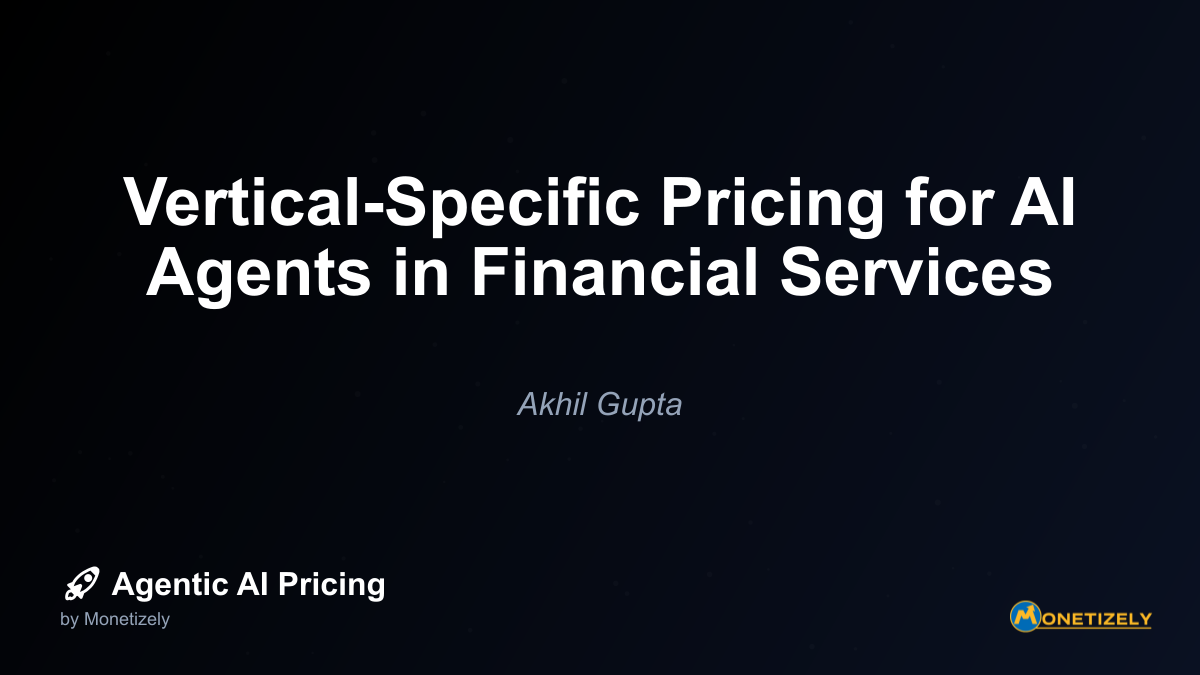
The financial services industry stands at the precipice of a transformational shift driven by AI agents. As institutions increasingly adopt these intelligent systems to enhance operations, deliver personalized services, and manage risk, the question of how to price these technologies becomes critically important. This deep dive explores the nuanced landscape of vertical-specific pricing for AI agents in financial services, examining the unique considerations, compliance requirements, and value metrics that shape pricing strategies in this highly regulated sector.
The Evolving Landscape of AI Agent Pricing in Financial Services
Financial services organizations face unique challenges when implementing AI agents, requiring specialized pricing approaches that address industry-specific needs. Traditional pricing models are rapidly evolving as the market matures and organizations seek greater alignment between cost and value.
Recent market trends from 2023-2025 show a significant shift from conventional pricing structures toward more dynamic, outcome-based, and resource-usage frameworks. According to Grand View Research, the AI agent market in financial services was valued at approximately $490 million in 2024 and is projected to grow to over $4.4 billion by 2030, highlighting the explosive growth of this sector.
Among the various applications, fraud detection AI agents lead the market segment, capturing 33.4% of revenue share in 2024, with innovations in real-time anomaly detection and reduced false positives. Customer service agents powered by AI also show significant growth, reducing response times by 70% and human calls by 50%.
Key Pricing Models Emerging in Financial Services
Several pricing models have gained traction in the financial services sector, each with distinct advantages and considerations:
1. Risk-Adjusted and Dynamic Pricing
Agentic AI enables continuous real-time updates to risk assessments and pricing, moving beyond static traditional models that rely on limited data points like credit scores. These systems can integrate thousands of data indicators, including spending patterns and digital behavior, to optimize pricing dynamically for credit, insurance, and other financial products.
JPMorgan Chase’s AI-enhanced risk models, for example, increased default prediction accuracy by 35%, allowing better credit decisions while maintaining risk thresholds. To ensure fairness and regulatory compliance, financial institutions implement bias detection frameworks alongside these dynamic models.
2. Outcome-Based Pricing and Unbundling
In financial trading AI agents, pricing is shifting from flat subscriptions toward outcome-based models, which tie costs to specific, measurable financial objectives or trading outcomes. There’s also a trend toward unbundling pricing components such as strategy development, execution infrastructure, and data analytics, enabling more granular billing and value alignment with client needs.
3. Usage-Based and Resource-Based Pricing
Vendors increasingly adopt usage-based pricing, charging clients according to actual resource consumption (e.g., computing power, API calls), mirroring cloud service models. This offers flexibility but can introduce cost unpredictability as AI workloads vary. Usage-based models are favored during early piloting phases but are expected to evolve as deployments scale.
4. Agent-Based Pricing
A novel model gaining traction is pricing by AI “agent” — task-specific autonomous AI units that tackle discrete functions (e.g., AI for recruitment or accounting). Customers may pay a subscription or one-time fee per agent, with predictable costs resembling a digital labor salary. For example, pricing of specialist research agents is rumored around $20,000 per month, reflecting operational value rather than user count.
5. Collaborative and Open-Source Models
Some AI agent providers promote collaborative development, where financial institutions share costs and benefits of model development. Others offer open-source AI cores supplemented with premium features, allowing more inclusive access while monetizing advanced capabilities.
Value Metrics and ROI Considerations in Financial Services
Financial institutions measure the value and ROI of AI agents by focusing on a mix of hard financial metrics and softer performance indicators. Understanding these metrics is essential for both AI vendors and financial institutions to align pricing with actual value delivered.
Hard ROI Metrics
Financial services firms typically evaluate AI implementations based on several quantifiable metrics:
ROI multiples and break-even timelines: Agentic AI implementations deliver 3.5 to 6 times ROI compared to traditional AI tools, with break-even points often reached in less than 14 months. Larger-scale deployments can outperform pilot projects by 400% in financial return.
Revenue growth and cost reduction: Banks adopting AI agents report 3.5x higher revenue growth than non-adopters, coupled with 25-50% cost reductions in key processes such as fraud detection, credit risk assessment, and customer service.
Labor cost savings: Quantifiable reductions in manual processing time and associated labor costs. For example, JPMorgan’s COiN platform analyzed 12,000 commercial credit agreements in seconds versus what would have required 360,000 human hours.
Operational efficiency improvements: Measurable gains in processing speed, accuracy, and throughput. For instance, a leading investment tool provider achieved 200% scalability improvement and 40% reduction in data errors through AI implementation.
Profit contribution: Scaled AI workflows have increased operating profit margins progressively — 2.4% in 2022, rising to 7.7% in 2024. Top organizations report up to 18% ROI on AI efforts, surpassing common cost-of-capital benchmarks.
Soft ROI Metrics
Beyond direct financial impact, financial institutions also consider:
Improved employee satisfaction and retention: Reduction in mundane tasks and enhanced decision-making capabilities leading to higher job satisfaction.
Decision-making speed and accuracy: Faster, more consistent decisions based on AI-assisted analysis.
Customer satisfaction: Enhanced client experiences demonstrated by metrics like higher Net Promoter Scores (NPS), which are expected to rise significantly due to AI initiatives.
Risk reduction: Improved compliance outcomes and reduced operational risks, which are particularly valuable in the heavily regulated financial sector.
Regulatory Requirements and Compliance Frameworks
The financial services industry operates under stringent regulatory oversight, which significantly impacts AI implementation and pricing strategies. Recent regulatory developments from 2023-2025 have further shaped the compliance landscape for AI in financial services.
Key Regulatory Developments
Enhanced Federal Standards: Calls for consistent federal standards to avoid regulatory arbitrage and conflicting state laws affecting financial firms deploying AI, especially generative AI. The U.S. Treasury recommends collaboration between NIST and Treasury for a financial sector-specific AI risk profile based on the NIST AI Risk Management Framework.
Financial Stability Oversight Council (FSOC): In its 2024 report, FSOC highlighted AI as both an opportunity and systemic risk for financial services, calling for a “sliding scale” regulatory oversight calibrated to risk level, emphasizing the need to balance innovation with safeguards to prevent consumer harm, bias, and cybersecurity vulnerabilities.
UK’s Financial Conduct Authority (FCA): The FCA has taken significant steps by clarifying existing regulatory frameworks’ applicability to AI, highlighting consumer trust and risk awareness, and promoting cross-border regulatory collaboration. It launched a “Supercharged Sandbox” with NVIDIA in 2025 to let firms safely test AI innovations.
State-Level Regulations: With the absence of a binding federal AI law as of mid-2025, state-level AI regulations focusing on bias, transparency, and compliance have effectively fragmented the legal landscape for financial AI applications.
Existing Laws Application: Existing laws like the Fair Credit Reporting Act (FCRA) and Equal Credit Opportunity Act (ECOA) are increasingly interpreted to cover AI-driven financial decisions, demanding transparency and non-discrimination from AI systems involved in credit scoring and lending decisions.
Compliance Costs and Pricing Impact
The complex and fragmented regulatory environment leads to increased compliance costs for AI vendors targeting financial institutions. These costs include:
- Investment in legal expertise to navigate federal, state, and international rules
- Enhanced AI governance, transparency, and bias mitigation mechanisms
- Implementation of robust audit and reporting tools aligned with frameworks like NIST AI RMF
These costs often influence pricing strategies by necessitating premium fees for AI solutions with built-in compliance assurances, auditability, and risk management features. Vendors able to demonstrate adherence to regulatory standards and offer sandbox-tested, explainable AI are better positioned to command higher prices from financial institutions seeking to avoid regulatory penalties.
Vendor Strategies for Compliance Integration
Leading vendors are addressing compliance requirements in their pricing models through several approaches:
Partnering with regulators: Large AI/cloud providers are partnering with regulators to offer secure, compliant AI testing environments (e.g., FCA’s Supercharged Sandbox with NVIDIA) where fees reflect the added value of regulatory-safe AI innovation platforms.
Embedding compliance tools: Vendors are embedding NIST AI Risk Management Framework alignment tools and continuous compliance reporting capabilities within their offerings, justifying premium tiers or enterprise pricing tailored to those requiring stringent regulatory adherence.
Modular compliance services: Some AI vendors offer modular pricing for additional compliance services, such as independent fairness audits, bias mitigation toolkits, or transparency reporting dashboards—priced separately to align with the specific regulatory requirements of financial customers across jurisdictions.
Segment-Specific Pricing Strategies
Financial services encompasses several distinct segments, each with unique AI application needs and corresponding pricing considerations. Understanding these segment-specific requirements is crucial for developing effective pricing strategies.
Banking
Banking institutions primarily leverage AI agents for fraud detection, customer service automation, risk assessment, and personalized banking experiences. Pricing strategies for banking typically focus on:
- Volume-based pricing: Aligning costs with transaction volumes or customer interactions
- Tiered subscription models: Combining fixed fees for standard AI access plus usage caps or overage charges for spikes, balancing cost predictability with scalability
- Risk-adjusted value metrics: Pricing based on the risk mitigation value provided, particularly for fraud detection and credit risk assessment
Case Study: JPMorgan Chase JPMorgan implemented the COiN platform, which uses machine learning and NLP to analyze contracts. While pricing details are proprietary, the system analyzed 12,000 commercial credit agreements in seconds versus what would have taken 360,000 human hours, delivering massive cost savings and operational efficiency.
Case Study: DBS Bank (2024) DBS Bank deployed an enterprise-wide AI implementation including 100+ algorithms for fraud prevention, personalization, and AI assistants. The bank achieved a 17% increase in funds saved from fraud attempts and handled 250,000 customer queries monthly with AI assistants, demonstrating the value of industrializing AI with broad internal adoption.
Insurance
Insurance companies utilize AI agents for claims processing, underwriting, fraud detection, and customer service. Pricing strategies in this segment often include:
- Outcome-based pricing: Tying costs to specific outcomes like reduced claims processing time or fraud detection rates
- Per-claim processing fees: Charging based on the volume and complexity of claims processed
- Risk-adjusted models: Pricing that reflects the value of improved risk assessment in underwriting
Insurance AI implementations have shown improvements in workflows, greater agent efficiency, streamlined document validation, reduced processing times, and customer satisfaction improvements, as documented in 2023-2025 reports.
Wealth Management
Wealth management firms employ AI agents for portfolio optimization, personalized investment advice, and client relationship management. Pricing approaches include:
- Assets under management (AUM) percentage: Pricing based on a percentage of assets being managed with AI assistance
- Agent-based pricing: Charging for specialized AI advisors that perform specific investment-related functions
- Performance-based fees: Pricing tied to investment performance improvements attributable to AI
Case Study: Leading Investment Tool Provider (2025) A leading investment tool provider implemented an AI-powered data quality monitoring tool with customizable ML anomaly detection. The solution delivered 200% scalability improvement, 40% reduction in data errors, and 30% faster processing, enabling reliable data for investment decisions and operational gains.
Implementation Challenges and Pricing Implications
Financial services organizations face several significant challenges when implementing AI agents, which directly impact pricing strategies and considerations.
Integration Costs and Vendor Dependencies
Financial firms often rely on third-party AI providers for complex models, such as large language models (LLMs). This dependency creates vendor lock-in risks, cost of transitioning between providers, and potential disruption in critical services. The initial capital investment for AI infrastructure, licenses, and ongoing maintenance is substantial, especially when bespoke AI models are developed or integrated with legacy systems.
Pricing Implication: Vendors should offer flexible and modular pricing aligned to usage, compute needs, or model customization, allowing financial firms to scale costs with adoption and benefit realization without overcommitting upfront.
Infrastructure Requirements
Running and maintaining AI agents requires robust cloud computing capacity, data aggregation capabilities, and secure, scalable storage solutions. Financial institutions frequently leverage cloud platforms but must invest heavily in cybersecurity and compliance controls alongside these.
Pricing Implication: Vendors can assist clients by clearly outlining infrastructure requirements and offering packages that integrate cloud compute with AI services, helping manage total cost of ownership and infrastructure complexity.
Data Privacy, Security, and Regulatory Complexity
Sharing sensitive financial data, especially across borders, raises compliance and cybersecurity challenges, which are compounded by evolving AI regulations and standards. Firms must navigate unclear jurisdictional rules and fast-changing laws around AI transparency and fairness.
Pricing Implication: Including ongoing compliance monitoring, model auditing, and update services to reduce operational risks and help firms meet regulatory standards can justify premium fees and foster trust.
Common Pitfalls: Operational, Legal, and Strategic Risks
Operationally, overreliance on third-party AI and data providers increases the risk of service outages, reputational damage, and system failures. Firms may face legal liabilities for unauthorized use of copyrighted data in training AI and for inaccuracies in AI-driven customer interactions. Strategic risks arise when core functions such as customer acquisition are outsourced or heavily AI-dependent, potentially destabilizing firm liquidity or competitive positioning.
Pricing Implication: Pricing models that share risk or link costs to actual performance (e.g., efficiency gains or revenue growth driven by AI) can align vendor incentives with client success and reduce client adoption friction.
Future Trends in Financial Services AI Pricing
The landscape of AI agent pricing in financial services continues to evolve rapidly. Understanding emerging trends is essential for both vendors and financial institutions to develop forward-looking pricing strategies.
Decline of Traditional Pricing Models
Seat-based pricing models, which charge per user, are rapidly falling out of favor. They dropped from 21% to 15% of AI companies using them within just a year around 2024-25. Seat pricing poorly aligns with AI’s value, especially as large organizations generate a significant portion of output via AI, pushing companies toward other models.
Growth of Hybrid and Usage-Based Models
Hybrid pricing models combining multiple elements surged from 27% to 41%. Pure usage-based models, charging customers based on AI resource consumption (compute cycles, API calls), are popular for flexibility and managing infrastructure cost volatility, though they can be unpredictable for enterprise budgeting.
Increased Focus on Outcome and Value Alignment
Businesses increasingly demand cost models tied to realized business outcomes or capabilities, not just usage metrics. This aligns price with incremental functionality AI delivers, such as accelerated closing of books or autonomous candidate screening, providing clearer ROI.
Tension Between Software-Like and Utility-Like Pricing
Experts debate whether AI pricing will eventually resemble traditional SaaS (high-margin, declining prices due to scale) or utility models (pay as you go like electricity). Both models co-exist, with an emphasis on sustainability and balancing cost vs. value creation prevalent in financial services spending.
Investment and Market Growth
Financial institutions are substantially increasing AI investments—$35 billion spent in 2023 with projections up to $97 billion by 2027. This spending underpins the commercial pressure to innovate pricing to sustain margins and align costs with AI-driven productivity gains.
Developing an Effective Pricing Framework for Financial Services AI
Based on the insights gathered from market trends, regulatory requirements, and implementation challenges, we can outline a comprehensive framework for developing effective pricing strategies for AI agents in financial services.
Step 1: Identify Value Metrics Specific to Financial Services
The first step is to identify and quantify the specific value that AI agents deliver in financial services contexts:
- Risk reduction value: Quantify the impact of improved risk assessment, fraud detection, and compliance outcomes
- Operational efficiency gains: Measure time and cost savings from automated processes
- Revenue enhancement: Assess the impact on customer acquisition, retention, and cross-selling
- Strategic advantages: Evaluate competitive differentiation and market positioning benefits
Step 2: Align Pricing Structure with Value Delivery
Select pricing structures that align with how value is created and captured:
- For fraud detection and risk management, consider outcome-based pricing tied to risk reduction metrics
- For customer service applications, usage-based pricing aligned with interaction volumes may be appropriate
- For wealth management and advisory services, consider performance-based or AUM-linked pricing
Step 3: Account for Regulatory Compliance Costs
Factor regulatory compliance requirements into pricing strategies:
- Include compliance capabilities as premium features or bundled components
- Consider modular pricing for specific compliance tools or certifications
- Develop pricing tiers based on regulatory risk levels and compliance needs
Step 4: Design for Scalability and Flexibility
Create pricing models that accommodate growth and changing needs:
- Implement tiered pricing structures that scale with usage or value delivered
- Offer flexible contract terms that allow for adjustments as regulations evolve
- Consider hybrid models that combine fixed and variable components for predictability and scalability
Step 5: Incorporate Total Cost of Ownership Considerations
Account for all costs associated with AI implementation:
- Factor in integration costs with existing systems
- Consider infrastructure requirements and associated expenses
- Include ongoing maintenance, updates, and support in pricing calculations
Case Studies: Successful AI Pricing in Financial Services
Examining real-world implementations provides valuable insights into effective pricing strategies for AI agents in financial
Co-Founder & COO
Akhil is an Engineering leader with over 16+ years of experience in building, managing and scaling web-scale, high throughput enterprise applications and teams. He has worked with and led technology teams at FabAlley, BuildSupply and Healthians. He is a graduate from Delhi College of Engineering and UC Berkeley certified CTO.
Pricing Strategy Audit
Let our experts analyze your current pricing strategy and identify opportunities for improvement. Our data-driven assessment will help you unlock untapped revenue potential and optimize your AI pricing approach.

